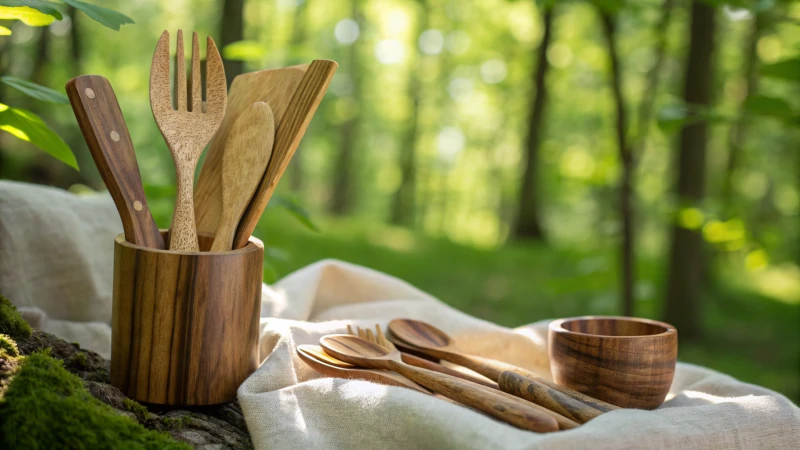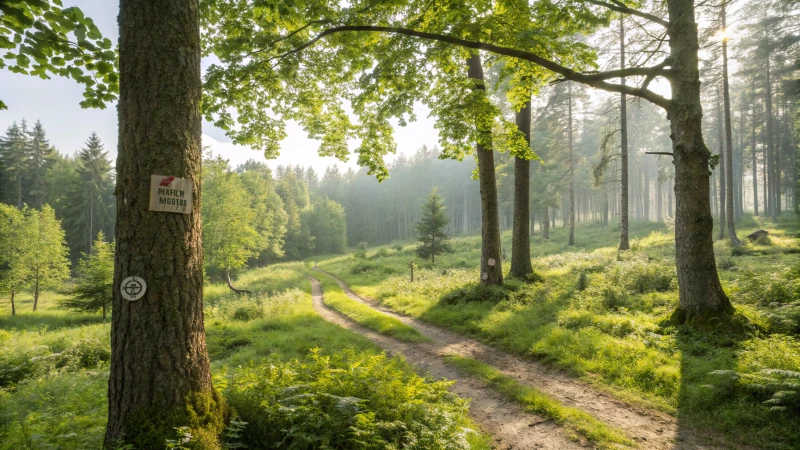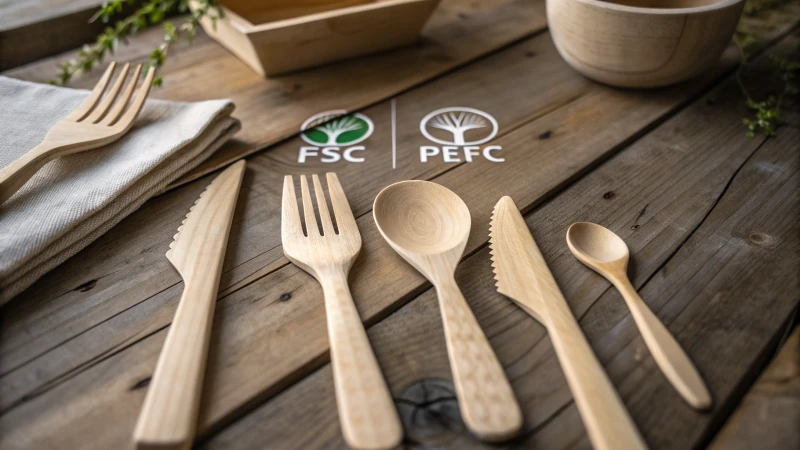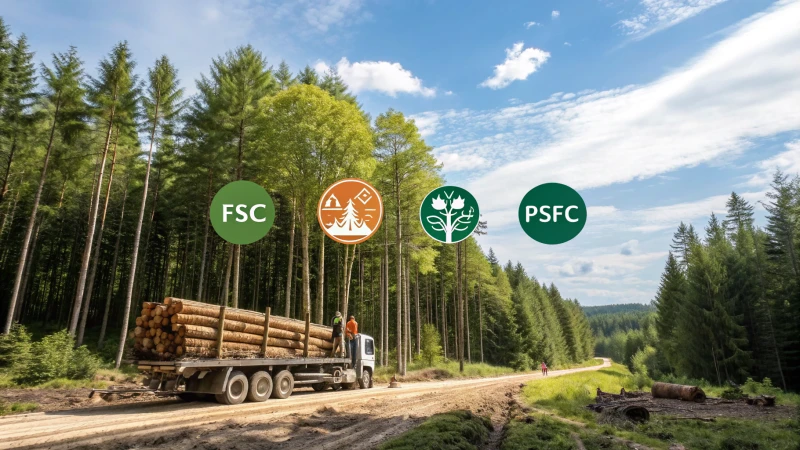
Ever wondered what goes into crafting that elegant wooden fork you're using?
Sourcing wood for sustainable cutlery production is no walk in the park. It involves ensuring legal and ethical harvesting, managing forests responsibly, and securing environmental certifications. Tackling these challenges is vital for maintaining a sustainable supply chain and offering truly eco-friendly products.
When I first ventured into the world of sustainable cutlery, I was taken aback by the complexities involved in sourcing wood responsibly. It's not just about finding the right type of wood but ensuring that it's harvested in a way that respects both the environment and the local communities. This journey has been about more than just compliance; it’s about building trust and creating products that genuinely make a difference. In this post, let's explore these hurdles and discover ways to overcome them, ensuring that our wooden cutlery stands as a beacon of sustainability.
Sustainable wood sourcing always ensures legal harvesting.False
Illegal logging can occur despite sustainability efforts, due to weak enforcement.
Environmental certifications are crucial for sustainable cutlery.True
Certifications ensure wood is sourced responsibly, supporting eco-friendly production.
How can I ensure the wood I use is legally harvested?
You know, ensuring the wood you use is legally harvested isn't just about ticking boxes—it's about making a genuine impact on our planet.
To ensure legal wood harvesting, I focus on securing certifications like FSC and PEFC, diligently monitoring supply chains, and leveraging traceability systems to confirm the wood's origins.

Understanding Wood Certification Systems
I remember when I first stumbled upon the Forest Stewardship Council (FSC) and the Programme for the Endorsement of Forest Certification (PEFC). It was like finding a roadmap in a maze of sustainability jargon. These certifications reassure me that the wood products I choose come from forests managed with care and responsibility.
| Certification | Key Focus | Region |
|---|---|---|
| FSC | Social, Economic, Environmental Standards | Global |
| PEFC | Local Forestry Management Compliance | Europe, Asia |
Implementing Due Diligence in Supply Chains
Early on, I learned that due diligence wasn't just a corporate buzzword—it was an absolute necessity. Tracking the journey of wood from forest to final product became my daily ritual. Each documented step reassured me that compliance with legal standards was not only met but exceeded. Satellite technology? A game-changer that helped me sleep better at night knowing every tree was accounted for.
Supply chain transparency1 isn't just a process; it's peace of mind.
Embracing Traceability Systems
Imagine being able to trace a piece of wood back to its origin with just a scan. That’s what advanced traceability systems offer. These digital tags or unique identifiers have made avoiding illegal logging much more straightforward. They’ve also given me the power to maintain impeccable records of legal compliance, something my eco-conscious customers truly value.
Using tools like blockchain has taken supply chain traceability2 to another level, ensuring all data remains secure and accessible.
Engaging with Responsible Sourcing Initiatives
Navigating international laws can be daunting, but engaging with initiatives like the EU Timber Regulation or the Lacey Act in the U.S. has been enlightening. These initiatives have become vital allies in my quest to adhere to legal sourcing. Adopting these strategies not only aligns me with sustainability goals but also strengthens my market position by appealing to consumers who care deeply about ethical products3.
FSC certification is only for European forests.False
FSC is a global certification, not limited to Europe.
Blockchain can enhance wood traceability systems.True
Blockchain provides tamper-proof, accessible data for traceability.
How Do Forest Management Practices Contribute to Sustainability?
Imagine standing in a lush forest, breathing in the fresh scent of pine and earth. Forest management is the art of preserving this natural beauty while meeting human needs.
Forest management practices play a vital role in sustainability by protecting biodiversity, reducing deforestation, and ensuring the responsible use of forest resources. These strategies harmonize ecological, economic, and social elements to sustain forest vitality.

The Multifaceted Impact of Forest Management Practices
When I first stepped into a role focused on sustainable development4, I quickly learned that forest management is not just about planting trees; it's an intricate dance of balancing nature's needs with our own. This balance is crucial for tackling climate change, preserving biodiversity, and meeting the socio-economic demands of communities.
Ecological Preservation
I remember visiting a community that practiced selective logging—a technique that allows certain trees to be harvested while keeping the forest's overall structure intact. Watching this in action made me realize how it minimizes habitat disruption. Controlled burns were another eye-opener, as they prevent wildfires by managing excess vegetation. Then there's reforestation, a process I saw firsthand in a global initiative where forests were replenished, enhancing carbon capture and giving back to the planet.
| Practice | Benefits | Examples |
|---|---|---|
| Selective Logging | Minimizes habitat disruption | Sustainable forestry5 in Amazonia |
| Controlled Burns | Prevents wildfires | Fire management in Australian bushlands |
| Reforestation | Increases carbon capture | Global replanting initiatives |
Socio-Economic Benefits
During a visit to a rural community reliant on forests for their livelihood, I was struck by how sustainable management practices uplifted local economies. By providing jobs and resources without jeopardizing future availability, these communities thrived. Community-based forest management empowered locals to oversee and profit from their resources, ensuring long-term economic stability.
Certification and Compliance
Ensuring forests are managed sustainably is not just about practice but also certification. I learned the significance of certifications like the Forest Stewardship Council (FSC) and Programme for the Endorsement of Forest Certification (PEFC). These stamps of approval require strict adherence to environmental standards, making sure wood products are responsibly sourced. This not only aids conservation but also reassures consumers about the ethical sourcing of products they purchase.
In my journey through procurement and sustainability initiatives, understanding these dynamics became crucial. As consumer demand for eco-friendly products grows, so does the need for comprehensive knowledge6 of sustainable forest management practices.
Selective logging minimizes habitat disruption.True
Selective logging involves harvesting specific trees, preserving forest structure.
Controlled burns increase the risk of wildfires.False
Controlled burns reduce excess vegetation, thereby lowering wildfire risk.
Why Are Environmental Certifications Crucial for Wooden Cutlery?
Imagine a world where every meal helps save the planet—sounds dreamy, right? Wooden cutlery makes this possible, but only with the right certifications.
Environmental certifications like FSC and PEFC are crucial for wooden cutlery because they guarantee sustainable sourcing and eco-friendly production, ensuring products meet environmental standards and appeal to eco-conscious consumers.

Understanding Environmental Certifications
When I first learned about environmental certifications like the Forest Stewardship Council (FSC) and Programme for the Endorsement of Forest Certification (PEFC), it felt like discovering a secret handshake among eco-warriors. These certifications ensure that wooden cutlery isn't just plucked from any forest but comes from places where trees are cherished and nurtured back to life. It's like knowing the backstory of your favorite novel—you appreciate it so much more.
The Role of Legal Harvesting
Once, during a trip to a lush forest, I was struck by how important it is to maintain the delicate balance of nature. That’s exactly what legal harvesting does—it makes sure the wood used for your wooden fork wasn't part of some illegal logging spree. Instead, it's about safeguarding biodiversity7 and keeping our forests thriving, so they’re around for future generations to marvel at.
Promoting Sustainable Forest Management
Sustainable forest management feels like preparing a perfect cup of tea. You want the right mix to balance ecological, economic, and social needs. Certified forests have management plans8 that are like those perfect recipes, supporting forest regeneration and ensuring they remain vibrant and full of life.
| Certification | Key Benefits |
|---|---|
| FSC | Ensures responsible sourcing, protects biodiversity |
| PEFC | Promotes sustainable forest management |
Assurance for Eco-Conscious Consumers
Think about it: when you choose certified wooden cutlery, you're making a statement. It's like wearing a badge that says, "I care about our planet." For businesses, it’s a golden ticket to building trust with eco-savvy customers who want reassurance that their choices make a difference. This commitment to sustainability can transform your brand into a beacon of hope in an increasingly eco-conscious market.
Implications for Suppliers and Manufacturers
For manufacturers, diving into certified wooden cutlery isn't just about hugging trees—it's about unlocking opportunities. Many sectors, from healthcare9 to hospitality, are increasingly demanding products that meet stringent sustainability standards. By embracing these certifications, suppliers not only comply with environmental regulations but also tap into new markets, ensuring their products are welcomed and celebrated by customers who value quality and care for the environment.
Incorporating environmental certifications into wooden cutlery production isn't just a trend—it's a necessary step towards a sustainable future that resonates with eco-conscious values and creates lasting partnerships built on trust and mutual benefit.
FSC certification ensures wood is from sustainably managed forests.True
FSC certification mandates responsible forestry, ensuring sustainability.
PEFC certification is not related to legal wood harvesting.False
PEFC ensures wood is legally harvested, preventing illegal logging.
How can I build a reliable supply chain for sustainable wood?
Building a sustainable wood supply chain is more than a business move—it's a commitment to the planet. Let's explore how to make it happen.
Creating a reliable supply chain for sustainable wood involves choosing certified sources, ensuring transparency, and forming partnerships with ethical suppliers. Certifications like FSC or PEFC guarantee sustainable harvesting practices.

I remember the first time I stood in a dense, untouched forest. The towering trees whispered stories of resilience, and I knew that any business I led would honor their legacy. Building a reliable supply chain for sustainable wood is about protecting these natural wonders while meeting business needs.
Understanding Sustainability Certifications
When I embarked on my journey towards sustainability, one of my first steps was learning about certifications like the Forest Stewardship Council10 (FSC) and the Programme for the Endorsement of Forest Certification11 (PEFC). These certifications are not just stamps; they are assurances that our wood comes from responsibly managed forests. They stand for legal compliance and efforts to prevent deforestation, giving me peace of mind that I'm doing my part.
Engaging with Responsible Suppliers
Choosing the right suppliers felt like finding allies in a mission larger than any single company. I dug deep into their environmental policies12, analyzed their transparency, and examined their history of sustainability. Working with suppliers who share a commitment to eco-friendly practices ensures that every piece of wood we use tells a story of ethical sourcing.
| Key Elements | Description |
|---|---|
| Sustainable Sourcing | Engage with certified suppliers who follow responsible forestry practices. |
| Transparency | Ensure all stakeholders in the supply chain have access to information about sourcing and logistics. |
| Partnerships | Build long-term relationships with suppliers who are committed to sustainability initiatives. |
Implementing Sustainable Logistics Practices
Efficient logistics are the backbone of a reliable supply chain. I sought out partners who minimized carbon footprints using green technologies13, like electric vehicles and optimized routes, showing that even our transportation respects the earth.
Leveraging Technology for Traceability
Incorporating technology like blockchain has revolutionized how I track wood from forest to final product. This level of traceability ensures accountability at every stage, maintaining consumer trust by providing transparency across all levels of the supply chain.
Continuous Improvement and Innovation
The journey doesn't end at setup; it’s about constant evolution. I regularly assess our practices, diving into research on new materials or methods that could further enhance sustainability. By integrating advanced analytics14, I optimize operations and predict disruptions, always aligning with the latest standards and consumer expectations.
Each step I've taken in this journey reflects a deeper belief that business success and environmental stewardship can walk hand in hand.
FSC certification guarantees wood is from responsibly managed forests.True
FSC certification ensures wood is sourced sustainably, verifying responsible management.
Blockchain technology cannot enhance supply chain traceability.False
Blockchain provides transparency and accountability, improving traceability in supply chains.
Conclusion
Sourcing wood for sustainable cutlery involves overcoming challenges like legal harvesting, responsible forest management, and securing environmental certifications to ensure eco-friendly production and supply chain integrity.
-
Learn methods to verify and document each step in the wood supply chain. ↩
-
Discover how blockchain technology secures and tracks product origin data. ↩
-
Explore why consumers are increasingly prioritizing ethically sourced products. ↩
-
Exploring sustainable development can help you understand its essential role in balancing environmental health with human progress. ↩
-
Discover real-world examples of sustainable forestry practices to gain insights into their implementation and effectiveness. ↩
-
Learning about sustainable forest management benefits procurement and sustainability efforts by informing better decision-making. ↩
-
Discover the role of legal harvesting in maintaining ecological balance and biodiversity. ↩
-
Explore strategies that ensure forests meet environmental, economic, and social needs. ↩
-
Understand how sustainability influences healthcare supply choices and impacts patient care. ↩
-
Learn how FSC certification ensures that wood products come from responsibly managed forests. ↩
-
Discover how PEFC certification supports sustainable forest management worldwide. ↩
-
Explore methods to assess supplier commitments to environmental standards effectively. ↩
-
Find out how green technologies in logistics can help reduce environmental impact. ↩
-
Learn how advanced analytics can optimize supply chain operations and prevent disruptions. ↩

